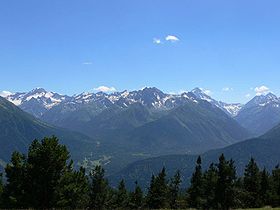Greater Caucasus
| Greater Caucasus | |
|---|---|

Mountainous landscape of Arkhyz
|
|
| Highest point | |
| Peak | Mount Elbrus |
| Elevation | 5,642 m (18,510 ft) |
| Coordinates | 43°21′18″N 42°26′31″E / 43.35500°N 42.44194°ECoordinates: 43°21′18″N 42°26′31″E / 43.35500°N 42.44194°E |
| Dimensions | |
| Length | 1,200 km (750 mi) NW-SE |
| Geography | |
| Countries | Azerbaijan, Georgia and Russia |
| Parent range | Caucasus Mountains |
| Borders on | Lesser Caucasus |
Greater Caucasus (Azerbaijani: Böyük Qafqaz, Бөјүк Гафгаз, بيوک قافقاز; Georgian: დიდი კავკასიონი, Didi Ǩavǩasioni; Russian: Большой Кавказ, Bol’shoy Kavkaz, sometimes translated as "Caucasus Major", "Big Caucasus" or "Large Caucasus") is the major mountain range of the Caucasus Mountains.
The range stretches for about 1,200 kilometres (750 mi) from west-northwest to east-southeast, between the Taman Peninsula of the Black Sea to the Absheron Peninsula of the Caspian Sea: from the Western Caucasus in the vicinity of Sochi on the northeastern shore of the Black Sea and reaching nearly to Baku on the Caspian.
The range is traditionally separated into three parts:
In the wetter Western Caucasus, the mountains are heavily forested (deciduous forest up to 1,500 metres (4,900 ft), coniferous forest up to 2,500 metres (8,200 ft) and alpine meadows above the tree line). In the drier Eastern Caucasus, the mountains are mostly treeless.
The watershed of the Caucasus is also considered the boundary between Eastern Europe and Western Asia. The European part north of the watershed is known as Ciscaucasia, the Asiatic part to the south as Transcaucasia, which is dominated by the Lesser Caucasus mountain range and whose western portion converges with Eastern Anatolia.
...
Wikipedia

